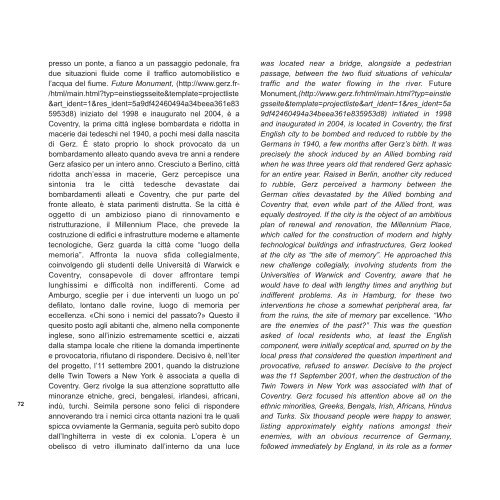Adachiara Zevi - arteinmemoria
Adachiara Zevi - arteinmemoria
Adachiara Zevi - arteinmemoria
You also want an ePaper? Increase the reach of your titles
YUMPU automatically turns print PDFs into web optimized ePapers that Google loves.
72<br />
presso un ponte, a fianco a un passaggio pedonale, fra<br />
due situazioni fluide come il traffico automobilistico e<br />
l’acqua del fiume. Future Monument, (http://www.gerz.fr-<br />
/html/main.html?typ=einstiegsseite&template=projectliste<br />
&art_ident=1&res_ident=5a9df42460494a34beea361e83<br />
5953d8) iniziato del 1998 e inaugurato nel 2004, è a<br />
Coventry, la prima città inglese bombardata e ridotta in<br />
macerie dai tedeschi nel 1940, a pochi mesi dalla nascita<br />
di Gerz. È stato proprio lo shock provocato da un<br />
bombardamento alleato quando aveva tre anni a rendere<br />
Gerz afasico per un intero anno. Cresciuto a Berlino, città<br />
ridotta anch’essa in macerie, Gerz percepisce una<br />
sintonia tra le città tedesche devastate dai<br />
bombardamenti alleati e Coventry, che pur parte del<br />
fronte alleato, è stata parimenti distrutta. Se la città è<br />
oggetto di un ambizioso piano di rinnovamento e<br />
ristrutturazione, il Millennium Place, che prevede la<br />
costruzione di edifici e infrastrutture moderne e altamente<br />
tecnologiche, Gerz guarda la città come “luogo della<br />
memoria”. Affronta la nuova sfida collegialmente,<br />
coinvolgendo gli studenti delle Università di Warwick e<br />
Coventry, consapevole di dover affrontare tempi<br />
lunghissimi e difficoltà non indifferenti. Come ad<br />
Amburgo, sceglie per i due interventi un luogo un po’<br />
defilato, lontano dalle rovine, luogo di memoria per<br />
eccellenza. «Chi sono i nemici del passato?» Questo il<br />
quesito posto agli abitanti che, almeno nella componente<br />
inglese, sono all’inizio estremamente scettici e, aizzati<br />
dalla stampa locale che ritiene la domanda impertinente<br />
e provocatoria, rifiutano di rispondere. Decisivo è, nell’iter<br />
del progetto, l’11 settembre 2001, quando la distruzione<br />
delle Twin Towers a New York è associata a quella di<br />
Coventry. Gerz rivolge la sua attenzione soprattutto alle<br />
minoranze etniche, greci, bengalesi, irlandesi, africani,<br />
indù, turchi. Seimila persone sono felici di rispondere<br />
annoverando tra i nemici circa ottanta nazioni tra le quali<br />
spicca ovviamente la Germania, seguita però subito dopo<br />
dall’Inghilterra in veste di ex colonia. L’opera è un<br />
obelisco di vetro illuminato dall’interno da una luce<br />
was located near a bridge, alongside a pedestrian<br />
passage, between the two fluid situations of vehicular<br />
traffic and the water flowing in the river. Future<br />
Monument,(http://www.gerz.fr/html/main.html?typ=einstie<br />
gsseite&template=projectliste&art_ident=1&res_ident=5a<br />
9df42460494a34beea361e835953d8) initiated in 1998<br />
and inaugurated in 2004, is located in Coventry, the first<br />
English city to be bombed and reduced to rubble by the<br />
Germans in 1940, a few months after Gerz’s birth. It was<br />
precisely the shock induced by an Allied bombing raid<br />
when he was three years old that rendered Gerz aphasic<br />
for an entire year. Raised in Berlin, another city reduced<br />
to rubble, Gerz perceived a harmony between the<br />
German cities devastated by the Allied bombing and<br />
Coventry that, even while part of the Allied front, was<br />
equally destroyed. If the city is the object of an ambitious<br />
plan of renewal and renovation, the Millennium Place,<br />
which called for the construction of modern and highly<br />
technological buildings and infrastructures, Gerz looked<br />
at the city as “the site of memory”. He approached this<br />
new challenge collegially, involving students from the<br />
Universities of Warwick and Coventry, aware that he<br />
would have to deal with lengthy times and anything but<br />
indifferent problems. As in Hamburg, for these two<br />
interventions he chose a somewhat peripheral area, far<br />
from the ruins, the site of memory par excellence. “Who<br />
are the enemies of the past?” This was the question<br />
asked of local residents who, at least the English<br />
component, were initially sceptical and, spurred on by the<br />
local press that considered the question impertinent and<br />
provocative, refused to answer. Decisive to the project<br />
was the 11 September 2001, when the destruction of the<br />
Twin Towers in New York was associated with that of<br />
Coventry. Gerz focused his attention above all on the<br />
ethnic minorities, Greeks, Bengals, Irish, Africans, Hindus<br />
and Turks. Six thousand people were happy to answer,<br />
listing approximately eighty nations amongst their<br />
enemies, with an obvious recurrence of Germany,<br />
followed immediately by England, in its role as a former


